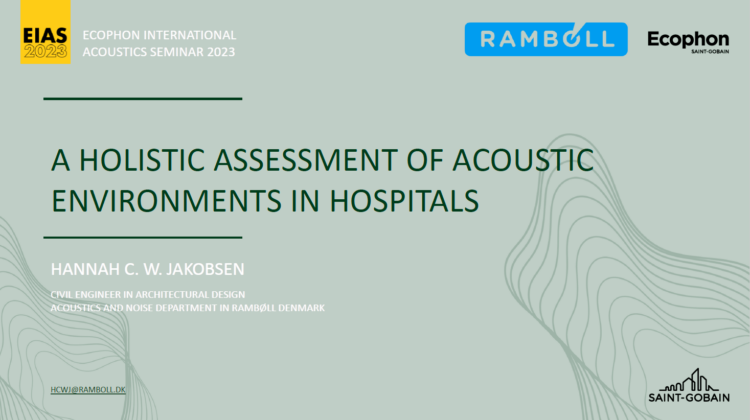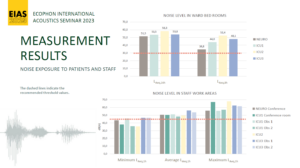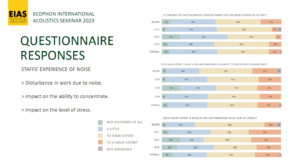
A “must-hear” presentation on satisfying sound environments for all legislators, architects, acoustics engineers, builders and hospital staff. This is how we would describe the presentation entitled “A holistic assessment of sound environment in hospitals” by Hannah C. W. Jakobsen (Ramboll Denmark) during the Ecophon International Acoustics Seminar 2023.

Satisfying sound environments
The presentation summarized a study of the acoustic environment in four Danish hospital wards. Three Intensive Care Units and one Neurological Emergency unit. The research had a holistic ethnographical approach and it came with a few surprises. One of them, and for me the major one, was that even though the requirements stated in the Danish building regulations were met satisfying sound environments were not achieved. Noise measurements conducted showed that both patients and staff were exposed to high levels of noise.
Impact of noise
Several studies outline the negative impact that noise has on patients in hospitals. Benefits of good sound environment includes lower rate of rehospitalization, quicker recovery time. As well as lower blood pressure and heart rate and even decrease in additional use of betablockers. Apart from impact on patients, noise in hospitals is influencing staff’s wellbeing and performance. Negatively affecting the occurrence of errors, level of stress and the overall job satisfaction.
Differences between countries
Unlike some European countries, the Netherlands belong to those with firm noise regulations of work environments, including hospitals. These regulations request reverberation time in ward bedrooms, examination, and treatment rooms to be below 0,6s at 125-2000Hz. The same applies for offices with maximum 4 occupants and meeting rooms.
The Danish Working Environment Authority requires noise level (LAeq) to be below 40-45 dB where concentration and clear communication is needed. Similar recommendations by the World Health Organization (WHO) requiring noise level were patients stay for longer periods of time to not exceed 30 dB throughout day and evening (16h). And at night-time (8h) a maximum 40 dB for sound event indoors.
Is the regulation enough?
The study conducted by Hannah concluded that even having legislation in place and respecting it in practice, is necessarily not enough for creating satisfying sound environments facilitating patients’ recovery.

The study of the sound environment was carried out using measured, objective parameters along with observations, supported by informal interviews and questionnaires filled out by staff, to obtain a holistic insight to the sound environments in Danish hospital units. The informal interviews revealed that more than half of the staff felt disturbed by the noise in their unit in the last 6 months to some or great extent.

About 61% of those interviewed complained about noise impacting their ability to concentrate to some or great extent. While a similar percentage (62%) believed that the noise is negatively impacting the level of stress at work on the same scale. Phones ringing and doors opening and closing have been identified as the most annoying noise source by the staff. When asked about the impact of noise on patients, more than two thirds of the staff believed that it has some or great impact on their recovery.
Finally, the results from the study have been compared to the findings of ethnographic studies performed in each unit to determine recommendations regarding acoustic design of future hospital units for both architects, acoustical engineers, and lawmakers.
Satisfying sound environments in the design phase
While there is always room to improve the regulations, early involvement of acoustic engineers in the design phase should be considered. This to avoid design choices working against good sound environments. To utilize best practices and lesson learnt, a wide range of methods should be used. Evalutaing the soundscapes in current units and comparing the different units.
The role of the architect is essential in the process. They should consider the acoustics, and workplace behavior that will impact the sound environment. Preferably early in the design phase. And especially in planning the layout of the unit and assigning room functions. Finally – legislators should consider the room functions in hospital facilities in the regulations. Collaboration is beneficial to create better sound environments in hospitals and Intensive Care Units to contribute to faster recovery.
Watch Hannah´s presentation at EIAS 2023 and find the abstract here!


